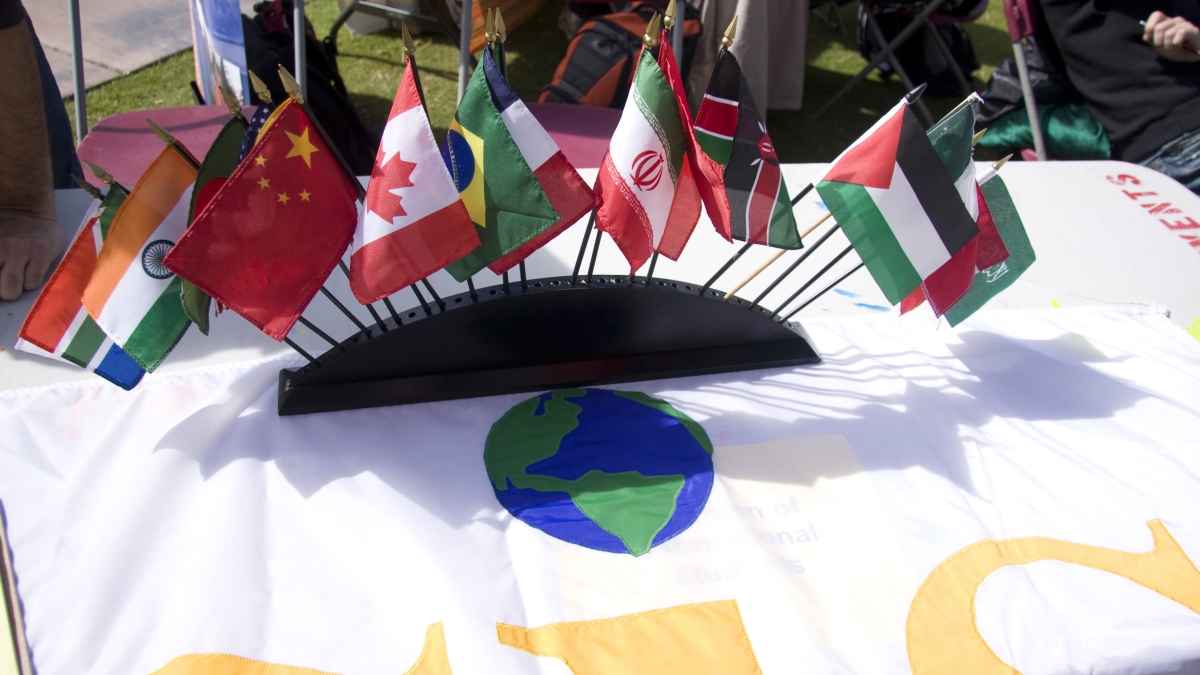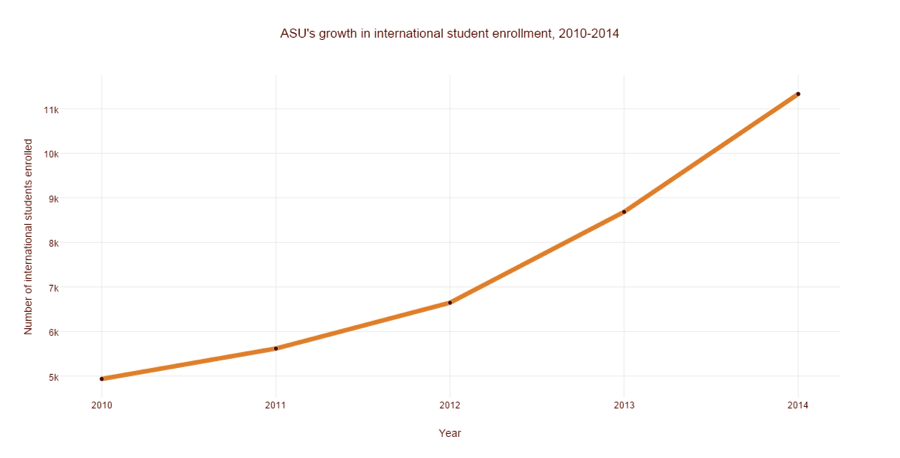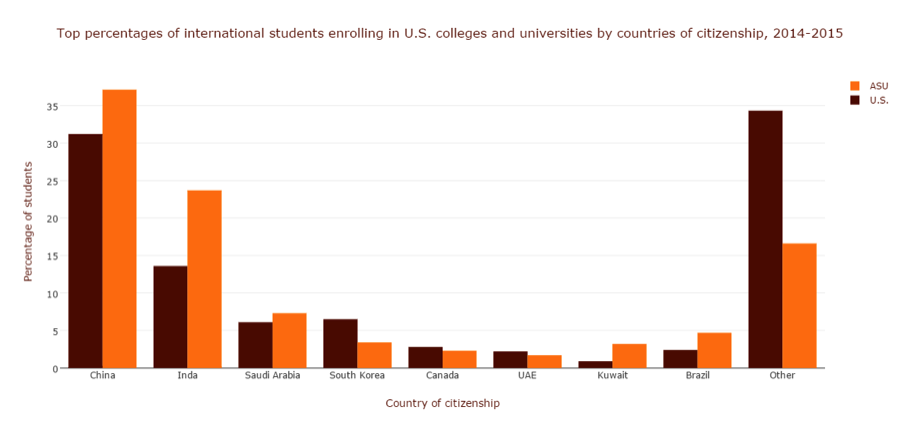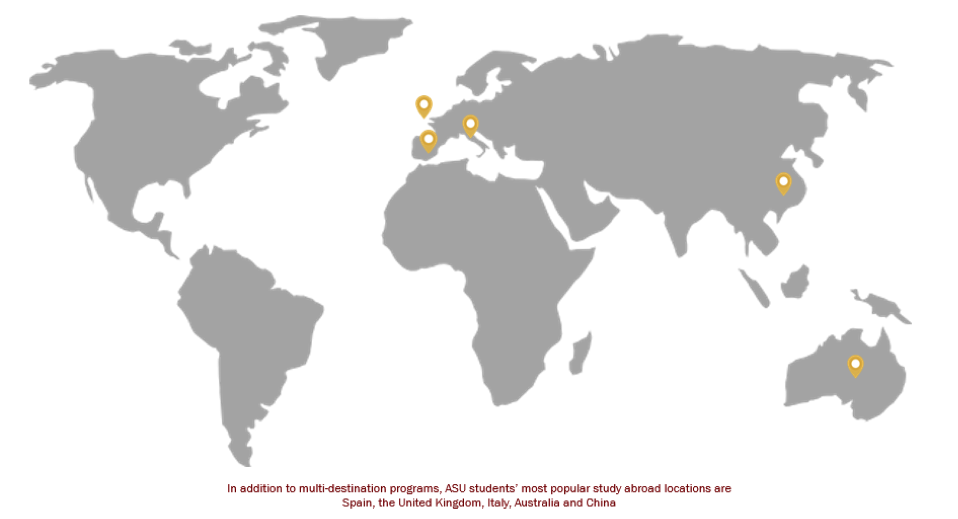Arizona State University ranked as the top public research institution and No. 4 overall college or university for international students, according to the 2015 Open Doors Report on International Educational Exchange released today. Open Doors also ranked ASU in the top 25 for domestic students studying abroad.
The report, published by the independent non-profit Institute of International Education (IIE), shows that a record number of international students attended U.S. colleges and universities in the 2014-2015 academic year.
Of the top 25 top institutions hosting international students, ASU demonstrated the largest percent increase in its international student population, hosting 11,330 students in 2014-2015 — growth of more than 30 percent.
“ASU’s reputation as the most innovative place of higher education in America is known and recognized overseas. Our record of excellence and impact is helping attract bright, diverse scholars from nearly every region of the globe,” said Interim University Provost Mark Searle. “Importantly, our international students join a diverse ASU community and through their participation contribute to all students’ understanding of an increasingly interconnected world.”
New York University, the University of Southern California and Columbia University in the City of New York were the report’s top three schools for enrolling students from other countries. California and New York rank as the top two states for hosting international students. Arizona ranks 13.
Open Doors reports that ASU’s international students represent more than half of global scholars attending a college or university in Arizona, and they contribute to an estimated $618 million in yearly student expenditures.
International student enrollment at ASU has more than doubled in the past five years. In that time, students from more than 150 countries have enrolled in undergraduate and graduate programs in every discipline.
International student enrollment at ASU has more than doubled in the past five years.
Bowei “William” Zhu is pursuing a bachelor’s degree in engineering management at the ASU Ira A. Fulton Schools of Engineering. He grew up in Guangzhou, in southern China, and quickly became involved in the university’s Chinese Student and Scholar Association. Zhu is now president of the organization and is working to build an ASU-Chinese community locally and in his home country. He said he picked ASU for its engineering program and also “because I like the weather.”
In a recent ASU Now story about programs and services to help international students adjust to life in the United States, Rozaliya Everstova — a native of Yakutsk, in Siberia, who is on track to graduate with a degree in computer information systems this spring — spoke about taking advantage of tutoring services when she began her new life in the desert.
Tutoring is one of many ASU programs available to integrate students from afar into life at an American university. These include the Coalition of International Students, which is made up of individual student groups from different nationalities; the International Students and Scholars Center, which advises students on a variety of concerns ranging from visas to job placements; and Global Launch, an academic preparation service, language training and professional development curriculum to help students adjust to the U.S. learning environment.
A record number of international students attended U.S. colleges and universities in the 2014-2015 academic year.
According to the IIE, international students are not the only ones who benefit from coming to the United States for their studies. Their research concludes that domestic and foreign national students alike develop the skills necessary to succeed in a global community by learning alongside those from diverse cultures. These competencies include international awareness, an understanding of differing viewpoints and the opportunity to become proficient in foreign languages — all which improve one’s economic competitiveness.
In addition to hosting international students on its five Arizona campuses, ASU is sending an increasing number of students to study abroad in one of its more than 250 programs in 55 countries. In 2015, the university became a partner school of Generation Study Abroad, a national campaign encouraging more U.S. students to study abroad and to expand diversity in race and ethnicity, academic disciplines and destinations for those who do. The university sent about 400 more students overseas to study in 2014-2015 than in the year before.
ASU is sending an increasing number of students to study abroad in one of its more than 250 programs in 55 countries. Above shows some of the most popular locations.
Growth is expected to continue as the ASU Study Abroad Office increases its campus activities to raise awareness of its programs and financial-aid opportunities, which includes a Study Abroad Fair today in the Tempe campus’ Memorial Union. The office awards more than 100 travel grant scholarships each year and was recently awarded nearly half a million dollars in scholarships for first-generation college students to study overseas. In addition to this funding from private support, ASU students can apply their financial aid and scholarship packages to spending a semester abroad.
Recently, ASU was rated as the third-best school for Fulbright award winners. Its most recent laurel as a top school for international students comes soon after it was ranked by U.S. News & World Report as the most innovative school in the United States and as a top 100 world university by the Academic Ranking of World Universities.
More Local, national and global affairs

Video series tells story of 'Resettled People'
What better way for the story of former refugees to be told than having the refugees tell those stories themselves.That’s the idea behind "STEM Dreams in Motion: Stories of Resettled People."Using…

Department of State and ASU host Government Leaders Forum to strengthen semiconductor supply chains
By Emilia FrancoAs the global demand for semiconductors accelerates — with projections reaching $1 trillion by 2030 — Arizona State University, in partnership with the U.S. Department of State,…

Environmental writer, ER doctor address violence, climate change, more at sold-out ASU event
“The difficulty of understanding the consequences of heat is amplified by conventional notions of what it means to be hot. In pop culture, hot is sexy, hot is cool, hot is new…” That excerpt was…



